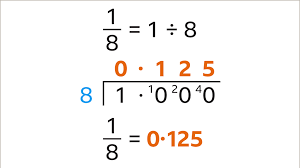In this article, you’ll learn how to convert fractions to decimals by focusing on the value of 9/8. We’ll guide you through the step-by-step process, highlight common mistakes to avoid, and explore real-life applications of this conversion.
Understanding the significance of 9/8 as a fraction will deepen your understanding of the relationship between fractions and decimals.
Get ready to gain insights and valuable tips for converting fractions to decimals, starting with the example of 9/8.
The Basics of Converting Fractions to Decimals
You should understand the importance of precision when converting fractions to decimals.
Converting fractions to decimals is a fundamental skill in math that allows you to express fractions in a more concise and convenient form.
To convert a fraction to a decimal, you divide the numerator by the denominator. For example, if you have the fraction 3/4, you divide 3 by 4 to get 0.75.
However, it’s crucial to remember that the precision of the decimal representation depends on the number of decimal places you choose to use.
If you round the decimal to two places, it becomes 0.75, but if you round it to three places, it becomes 0.750.
Therefore, understanding the importance of precision ensures accurate and meaningful conversions from fractions to decimals.
Understanding the Significance of 9/8 as a Fraction
To truly grasp the significance of 9/8 as a fraction, you need to delve into its decimal equivalent and explore the compound preposition that expresses its value.
Converting 9/8 to a decimal is a straightforward process. Simply divide 9 by 8, which equals 1.125. This decimal represents the value of 9/8 as a fraction in decimal form.
In terms of its compound preposition, 9/8 can be expressed as ‘one and one-eighth.’ This means that if you have one whole unit and add one-eighth of another unit, you’ll have a total of 9/8.
Understanding the decimal equivalent and compound preposition of 9/8 helps you better comprehend its value and allows you to work with fractions and decimals more effectively.
The Step-by-Step Process of Converting 9/8 to a Decimal
To convert 9/8 to a decimal, you divide 9 by 8.
The quotient is 1.125, which means that 9/8 is equal to 1.125 in decimal form.
Terminating or Repeating Decimal
Sometimes, converting a fraction like 9/8 to a decimal can result in a repeating decimal. When you divide 9 by 8, you get 1.125. However, this decimal isn’t repeating.
A repeating decimal occurs when the division of the numerator by the denominator produces a pattern that repeats indefinitely. If you were to continue dividing 9 by 8, you’d find that the decimal representation is 1.12500000… with the zeros repeating infinitely.
This means that the decimal representation of 9/8 is 1.125 with a bar over the zeros. The bar indicates that the zeros repeat indefinitely.
It’s important to recognize whether a fraction will result in a terminating or repeating decimal, as it affects the accuracy and precision of calculations.
Simplifying Before Converting?
You should simplify the fraction 9/8 before converting it to a decimal. Simplifying fractions allows you to work with smaller numbers and makes the conversion process easier. To simplify 9/8, you need to find the greatest common divisor (GCD) of the numerator and denominator, which in this case is 1. When the GCD is 1, it means that the fraction is already in its simplest form.
Now, let’s convert 9/8 into a decimal. Divide the numerator, 9, by the denominator, 8. The quotient is 1.125. So, the decimal representation of 9/8 is 1.125.
Common Mistakes to Avoid When Converting Fractions to Decimals
Don’t underestimate the significance of precision when converting fractions to decimals. It may seem like a simple task, but common mistakes can lead to inaccurate results.
One mistake to avoid is rounding too early in the process. When you convert a fraction to a decimal, it’s important to maintain accuracy by using all the digits in the calculation.
Another mistake is forgetting to divide the numerator by the denominator. This step is crucial for obtaining the correct decimal value.
Additionally, be cautious when dealing with repeating decimals. Remember to identify the repeating pattern and include the appropriate bar over the repeating digits.
Real-Life Applications of Converting Fractions to Decimals: The 9/8 Example
Do you ever wonder why converting fractions to decimals is important in real life?
Well, let’s take the example of 9/8.
Converting this fraction to a decimal can be useful in situations where you need to measure or calculate quantities that aren’t whole numbers, such as recipes or measurements.
Practical Uses of 9/8
Understanding the practicality of converting 9/8 into a decimal can help in accurately calculating the amount of fabric needed for sewing projects. When you convert 9/8 into a decimal, you get 1.125.
This decimal value represents the fraction as a decimal number, making it easier to work with when calculating measurements for sewing. For example, if you need to determine how much fabric is required for a dress pattern that requires 9/8 yards of fabric, converting the fraction to a decimal allows you to accurately measure out 1.125 yards of fabric.
This eliminates any confusion or miscalculations that could occur when working with fractions. By understanding the practicality of converting 9/8 into a decimal, you can ensure that you have the correct amount of fabric for your sewing projects.
Decimal Conversion Advantages
Converting fractions to decimals, like in the case of 9/8, simplifies calculations and allows you to accurately measure fabric for sewing projects. When you convert 9/8 to a decimal, you get 1.125. This decimal representation makes it easier to calculate the amount of fabric you need for your sewing project.
Instead of dealing with fractions, you can now work with a decimal value that’s easier to manipulate in calculations. For example, if you need to measure 1/4 of a yard of fabric, it’s much simpler to calculate 1/4 of 1.125 (which is 0.28125) rather than 1/4 of 9/8.
Converting fractions to decimals not only simplifies calculations but also enhances accuracy in measuring fabric for sewing projects.
Exploring the Relationship Between Fractions and Decimals: The Case of 9/8
Understand how fractions and decimals are related by exploring the case of 9/8. When you have a fraction, like 9/8, you can convert it into a decimal to better understand its value. To do this, you divide the numerator (9) by the denominator (8). The result is 1.125. This means that 9/8 is equivalent to 1.125 as a decimal.
By converting fractions to decimals, you can easily compare and work with different numbers. Decimals provide a more precise representation of fractions, allowing for easier calculations.
Understanding the relationship between fractions and decimals, such as in the case of 9/8, can help you solve mathematical problems more effectively and confidently. So, the next time you encounter a fraction, remember that you can always convert it to a decimal to gain a deeper understanding of its value.
Tips and Tricks for Converting Fractions to Decimals: Insights From the 9/8 Conversion
When converting fractions to decimals, you can gain valuable insights from the 9/8 conversion. By understanding how to convert the fraction 9/8 into a decimal, you can apply the same principles to convert other fractions as well.
To convert 9/8 into a decimal, you divide the numerator (9) by the denominator (8). The result is 1.125.
This conversion teaches us that the numerator becomes the whole number part of the decimal, while the denominator becomes the decimal’s decimal places. In other words, the fraction 9/8 can be represented as 1.125 in decimal form.
This process can be applied to any fraction, allowing you to easily convert fractions to decimals and gain a better understanding of their numerical value.
Conclusion
In conclusion, converting fractions to decimals is a valuable skill that has real-life applications. Understanding the significance of fractions like 9/8 and the step-by-step process of converting them to decimals is essential.
By avoiding common mistakes and using tips and tricks, you can easily convert fractions to decimals. The relationship between fractions and decimals, exemplified by the case of 9/8, further highlights the importance of this skill.
Keep practicing and exploring the world of fractions and decimals to enhance your mathematical abilities.


